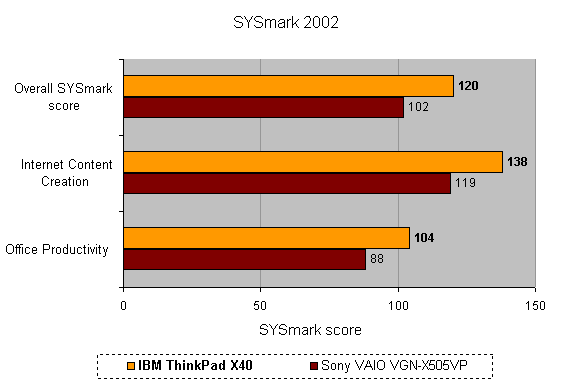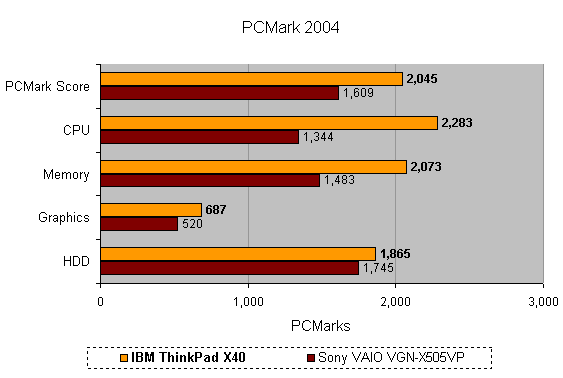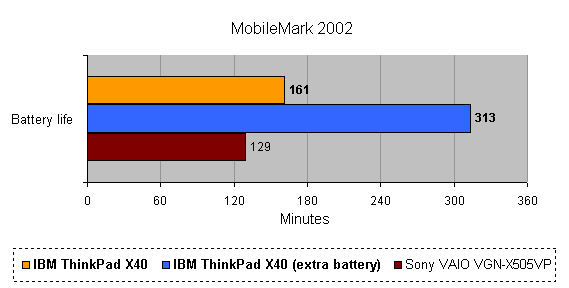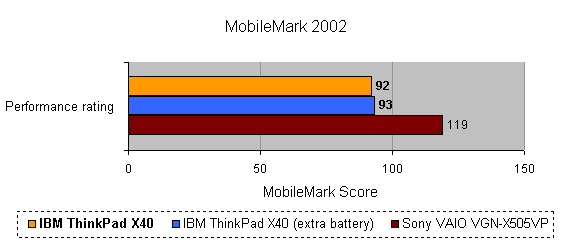IBM ThinkPad X40 – Ultra-Portable Notebook Review
IBM ThinkPad X40 – Ultra-Portable Notebook
The IBM ThinkPad X40 may not be as slim and light as the Sony X505VP, but it's a better all-round solution.

Verdict
Key Specifications
- Review Price: £1417.00
A few weeks ago I reviewed the Sony VAIO VGN-X505VP and proclaimed it the coolest notebook computer ever, and while I still stand by that statement, if I was going to put money on the table and buy an ultra-portable notebook, it would be this one – the IBM ThinkPad X40.
So what is it about the X40 that would lure me away from the ultra-sexy, featherweight Sony? Well, to be honest, there are a number of reasons why I love the X40, not least of which is the fact that for me, a notebook is a tool, and the easier that tool makes my life the better. In the X40 IBM has created a notebook computer that is slim and light, but still fully featured enough to keep me working on the move, no matter what I want to do.
With dimensions of 268 x 211 x 23.8mm (WxDxH) and a weight of 1.24kg, the X40 definitely falls into the ultra-portable category. In fact I took the X40 with me to Computex in Taipei a couple of weeks ago and I barely noticed that it was in my bag the whole time I was wandering around the show.
Whenever I see a notebook this small I worry that the ergonomics will suffer. When thinking of buying a notebook, there’s nothing more important than ergonomics. You might think that having the fastest processor or the biggest hard drive is paramount, but if the ergonomics are bad it won’t matter what the specification is. The ergonomic performance of a notebook is dependant on the keyboard, the pointing device and the screen, and a problem with any one of these components can ruin an otherwise excellent unit.
Upon opening the X40 I was thankfully greeted with a keyboard that’s up to IBM’s usual high standard. Despite the diminutive dimensions, IBM has still managed to fit a superb keyboard inside the X40, complete with almost full size keys. The travel on each key is perfect and the break is solid enough to spring your finger back for the next keystroke. The problem with many notebook keyboards is that the whole thing flexes when you’re typing. However, this is not a problem that affects IBM notebooks, where each key seems to be completely independent of the others and there is no keyboard flex no matter how hard your typing style. The Return key is large to facilitate easy striking, but the Backspace key remains small. The latter is unfortunate, but you have to accept some compromises in a chassis this small. The cursor keys are in the correct configuration and are set slightly away from the main keyboard. Also, as is traditional with IBM, the palm wrest is slightly cut away in front of the cursor keys to make it easy to slide your fingers into place. Finally, IBM’s customary keyboard light is also present. You may not think that this is a necessary addition, but if you’ve ever had to use a notebook in a dark environment, you’d be very glad to have the ability to illuminate the keyboard.
Anyone who’s a fan of touchpads will be disappointed with the X40, but personally I prefer TrackPoints anyway. The advantage of a TrackPoint is that you don’t have to take your hands away from their position over the keyboard when you’re using it. Also, the TrackPoints fitted to ThinkPads are the best I have ever used, and if you desire, you can even tap the TrackPoint and use it like the left selector button. Below the Spacebar are the left and right selector buttons, as well as a centrally mounted scroll lock button – when this is pressed you can move the TrackPoint up and down to scroll through a web page or document.
The last part of the ergonomic puzzle is the screen and the X40 sports a 12.1in display running a resolution of 1,024 x 768. As far as notebook resolutions go, this is pretty low by today’s standards, but with a screen this size it’s fine. I used the X40 as my only computer while I was in Taiwan for a week and I had no problem working with the screen size or resolution. Obviously I’d always prefer to have more desktop real estate, but then I also want a notebook that’s small and light, so you have to accept this trade off. As far as screens go, this is a good example with bright, even lighting and vivid colours. So, when it comes to ergonomics, the X40 has got everything right.
Looking to overal design, you either love or hate the ThinkPad range. Personally I really like the matt black finish, and the lid has a pleasing tactile rubbery feel to it. Unlike the ThinkPad X31 that I reviewed a few months back, the X40 has a single latch securing the lid. However, the single latch is connected to two locking hooks, so the lid will still stay securely shut, but you don’t have to press two latches to open it.
Inside the X40 you get a 1.2GHz Intel Pentium M backed up by 512MB of memory. There’s one free SODIM slot available so you can, in theory, expand the memory to 1.5GB. For storage there’s a 40GB hard disk which is capacious enough, but unfortunately with a 4,200rpm spindle speed it’s a little on the slow side. This is borne out by the fact that the X40 does take quite some time to boot up. Graphics come courtesy of the integrated Intel Extreme Graphics 2 chipset, so you won’t be playing any games, but that’s not really what a machine like this is for.
Wireless connectivity is well catered for with both integrated 802.11b and Bluetooth. It’s a little disappointing that the newer 802.11g standard isn’t supported, but most of the WiFi hotspots you’re likely to run into will more than likely be 802.11b. The reason why this X40 doesn’t have 802.11g is that it conforms to the original Centrino standard; however, certain X40 models ship with 802.11b/g or even 802.11a/b/g as standard, if you’re not worried about the Centrino badge. Bluetooth is always a useful inclusion and allows you to get connected to the Internet using a suitably equipped mobile phone. Of course if you don’t have Bluetooth on your phone, you can still connect via the IrDA port. Although many notebook manufacturers are dropping infrared, it’s good to see that IBM is still supporting the standard.
Taking a quick tour around the chassis you’ll notice that there is a surprising amount of connectivity integrated into the X40. On the right side there a single Type II PC Card slot, headphone and mic sockets, an SD card slot, an IrDA port, a USB port, a modem socket and an Ethernet port for the 10/100/1000 gigabit network adapter. On the left there’s a powered USB 2.0 port, a D-SUB connector, and the power socket. The rear is completely empty, since this is where the battery is mounted.
There is no optical drive built into the X40, and you don’t get one with it either. The optional X4 Ultrabase sits underneath the X40 and houses an optical drive as well as acting as a port replicator. The idea is that the Ultrabase will stay at home or in the office, and you plug the X40 into it whenever you are there. As well as housing an optical drive, you can keep your home/office network cable and power adapter plugged into the Ultrabase, so all you have to do is place the X40 onto it without having to fiddle around with cables. The Ultrabay retails for £158.62, so the convenience carries a pretty hefty price tag.
The X40 doesn’t ship with an optical drive, so you’re going to have to either invest in an Ultrabase with an optical drive but since the DVD/CD-RW combo drive that shipped with this review unit costs £225.60, you might as well buy an external USB optical drive instead. Alternatively, you can just share an optical drive on your desktop PC and install all your applications over the network.
You also get the usual ThinkPad extras like the Active Protection System to stop your hard disk getting damaged if you drop or knock the notebook while it’s on. The Rescue and Recover with Rapid Restore utility is also very useful and allows you to recover from a corrupted Windows environment or restore an image of your OS and data. The Embedded Security Subsystem 2.0 will also keep the more paranoid mobile users among us happy.
As far as performance goes, the X40 isn’t going to break any records, but an ultra-portable notebook isn’t aimed at the power hungry user. That said, I have happily used the X40 for the past few weeks, running everything from Word to Photoshop without any issues. What is important with a slim and light machine is battery life, and here it’s a game of two halves. Using the standard battery, the X40 turned in a time of two hours and 41 minutes. But when you add the base-mounted extra battery, this rises to five hours and 13 minutes. If you’re desperate for battery life you can get an extended battery that replaces the standard battery and still attach the base-mounted battery. The base-mounted battery adds 358g to the overall weight, and raises the X40 to a sloped typing angle that remains comfortable. The base-mounted battery will set you back £170.37, but if you’re serious about working on the move it’s worth the expense.
With a street price of £1,416.73 the X40 looks like pretty good value, especially when compared to the Sony X505VP, but then you did get a DVD writer with the Sony. If you do have to factor in the cost of an Ultrabase and optical drive, the price of the X40 will start to become less attractive, but if you’ve got a network set up at home or in the office, you should be able to install applications over the network and save on this expense. And if you don’t have a network, you can just get an external USB DVD writer for around £150.
IBM has come pretty close to producing the perfect ultra-portable notebook in the shape of the X40. The slightly slow boot up time and lack of 802.11g support are annoying, but still take little of the shine off this machine. Ultimately, as I said at the beginning, if I was going to buy a slim and light notebook computer, it would be this one.
”’Verdict”’
The X40 is slim, stylish, light and ergonomically superior to every other ultra-portable machine I’ve used. If you want a lightweight traveling companion, the X40 should be top of your list.
(table:features)




How we test laptops
Unlike other sites, we test every laptop we review thoroughly over an extended period of time. We use industry standard tests to compare features properly. We’ll always tell you what we find. We never, ever, accept money to review a product.
Trusted Score
Score in detail
-
Performance 8
-
Value 9
-
Features 9

